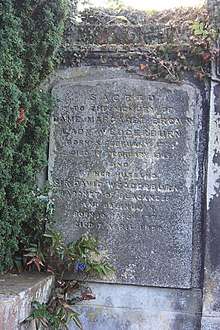Sir David Wedderburn, 1st Baronet
Sir David Wedderburn, 1st Baronet (10 March 1775[1] – 7 April 1858)[2] was a Scottish businessman and Tory politician. He was Postmaster General for Scotland 1823-31 and a member of two London militias before that.[3]
Family background
Wedderburn was the oldest surviving son of John Wedderburn (1729–1803, styled 6th Baronet) of Ballindean and his first wife Margaret Ogilvy, daughter of David Ogilvy (styled Lord Ogilvy). Both his father's and his mother's family had been attainted after the Jacobite rising of 1745, losing their titles, but his father continued to style himself as a baronet.[4]
His father had escaped to Jamaica after the execution of his own father, Sir John Wedderburn, 5th Baronet of Blackness, and had established a successful business based on slave sugar, trading with his brother and cousins in their London trading house Wedderburn, Webster & Co.
His mother died two weeks after his birth. When he was five years old, his father re-married, giving him as stepmother Alice Dundas,[5] who was related to Henry Dundas, 1st Viscount Melville, the Tory politician.[6] David Wedderburn had two full sisters, Margaret and Jean, and according to the Legacies of British Slave-ownership project, seven half-siblings. The eldest, James, died young.[7] John (1789–1862) succeeded David as the second baronet. (Genealogist Joseph Foster writes that the second baronet's children included David (1835-1882) and William (1838-1918), the third and fourth baronets respectively; the eldest son John had joined the Bengal Civil Service and died in the Indian Mutiny of 1857.[8]) Alexander (1791-1839) was a soldier. The four girls were Maria, Susan, Louisa Dorothea, and Anne. On 9 February 1803, aged 16, Louisa married General John Hope, 4th Earl of Hopetoun.[9] Anne married Sir John Hope, 11th Baronet Hope of Craighall.[10][7]
Business and politics

In 1796 David Wedderburn joined the business, at 35 Leadenhall Street in London, and made large profits. In 1803, he inherited his father's estates in Jamaica and at Ballindean, and was made a baronet,[4] of Ballindean in Perthshire.[11]
He was elected at a by-election in 1805 as the Member of Parliament (MP) for the Perth Burghs. He had the support of the 9th Earl of Kellie, but was opposed by Sir David Scott, 2nd Baronet, son of the deceased MP David Scott (of Dunninald). Scott had the support of the powerful Lord Melville, but by the time he began his canvassing, Wedderburn was too far ahead to be dislodged. He was re-elected unopposed at the next three general elections.[12]
In the House of Commons he voted as a loyal Tory, though after 1812 he did not attend Parliament frequently. He is believed to have never spoken in the Commons.[4]
Wedderburn left Wedderburn, Webster & Co in 1816 and retired from Parliament at the 1818 general election. He sold the Ballindean estate in 1820 to William Trotter for 67 000.[13] He served as Postmaster General for Scotland from 1823 to 1831.[4]
He is buried in Inveresk churchyard. The grave lies midway along the western boundary of the original churchyard, backing onto the Victorian cemetery.
Marriage and legacy
He married Margaret Brown (1775-1845). They had two sons, but both died before Sir David, so the title went to his half-brother, Sir John Wedderburn,[14] son of Alice Dundas.
See also
References
- Leigh Rayment's Historical List of MPs – Constituencies beginning with "P" (part 1)
- "Deaths". Dundee, Perth, and Cupar Advertiser. British Newspaper Archive. 9 April 1858. Retrieved 9 August 2014.
- "WEDDERBURN, Sir David, 1st Bt. (1775-1858), of Ballindean, Perth. | History of Parliament Online". www.historyofparliamentonline.org. Retrieved 3 August 2018.
- Fisher, David R. (1986). R. Thorne (ed.). "WEDDERBURN, Sir David, 1st Bt. (1775-1858), of Ballindean, Perth". The History of Parliament: the House of Commons 1790-1820. Boydell and Brewer. Retrieved 1 July 2014.
- Wedderburn biographical details at www.stanford.edu Retrieved June 2012
- "WEDDERBURN, Sir David, 1st Bt. (1775-1858), of Ballindean, Perth. | History of Parliament Online". www.historyofparliamentonline.org. Retrieved 9 April 2020.
- Legacy of British Slave-owners John Wedderburn of Balindean (1729 - 13th Jun 1803)
- Foster, Joseph. textsThe peerage, baronetage, and knightage of the British Empire : for 1882 (1883 ed.). Nicols & Sons. p. 646.
- Louisa Wedderburn at www.stanford.edu Retrieved June 2012
- Sir Bernard Brook (1880). A Genealogical and Heraldic Dictionary of the Peerage and Baronetage of the British Empire, Volume 42, Part 1. Henry Colburn. p. 646. Retrieved 29 July 2017.
- "London August 25". Aberdeen Journal. British Newspaper Archive. 31 August 1803. Retrieved 9 August 2014.
- Escott, Margaret (2009). D.R. Fisher (ed.). "Perth Burghs". The History of Parliament: the House of Commons 1820-1832. Cambridge University Press. Retrieved 1 July 2014.
- Jackson, Stephen (2006). "William Trotter, 1772-1833". The Book of the Old Edinburgh Club. Retrieved 9 April 2020.
- "Sir David Wedderburn 1st Bart. Profile & Legacies Summary". Legacies of British Slave-ownership. Retrieved 20 October 2016.
External links
- Hansard 1803–2005: contributions in Parliament by Sir David Wedderburn
- His entry at History of Parliament Online
| Parliament of the United Kingdom | ||
|---|---|---|
| Preceded by David Scott |
Member of Parliament for Perth Burghs 1805–1818 |
Succeeded by Archibald Campbell |
| Baronetage of the United Kingdom | ||
| New creation | Baronet (of Balindean, Perthshire) 1803–1858 |
Succeeded by John Wedderburn |